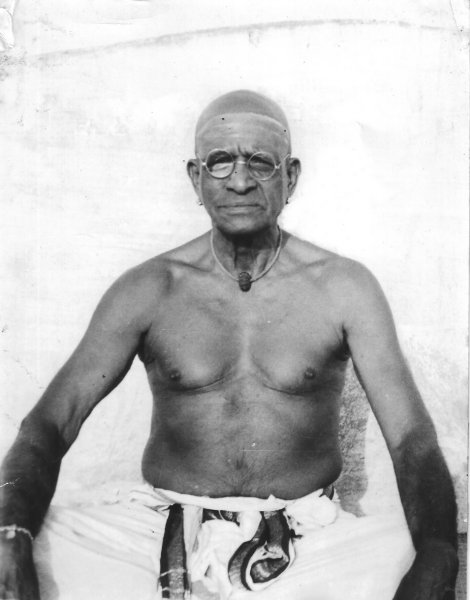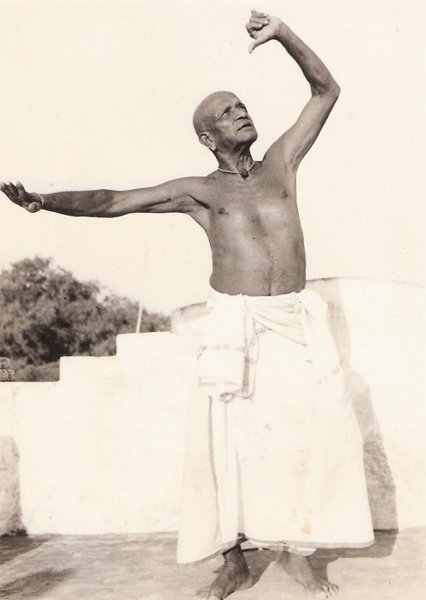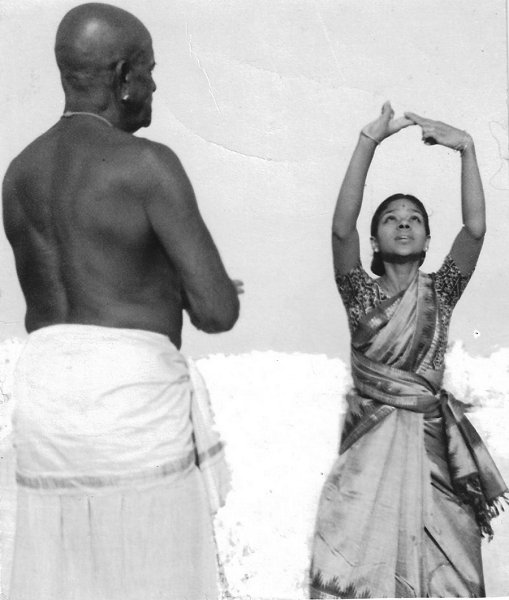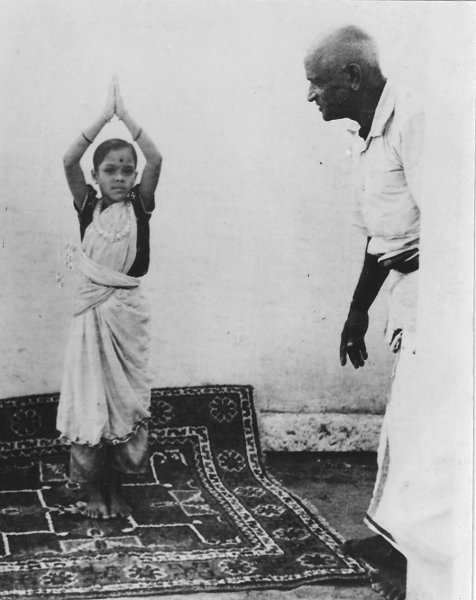
|   |

|   |
Vidwan Guru Muthukumaran Pillai: Stalwart and saint of Bharatanatyam - Ashish Mohan Khokar, Bangalore e-mail: khokar1960@gmail.com Based on archival materials from The Mohan Khokar Dance Collection August 30, 2009 If Bharatanatyam is known today worldwide (although some recent dictionaries and upstart magazines use small b, because in their western eyes it is not a proper noun; ditto for kathak and kathakali though in their eyes Flamenco and Salsa are propah nouns!), the credit goes to many pioneering gurus and nattuvunars of whom two reigned supreme - Guru Meenakshi Sundaram Pillai and Guru Muthukumaran Pillai - because under them, most of the first generation of front ranking Bharatanatyam dancers were trained. Thus the names of Guru Meenakshi Sundaram Pillai and Guru Muthukumaran Pillai, both just 6 years apart, is on tops as fountainheads of the form. Between them, they trained and polished nearly a dozen of top names of the pioneering period (1925-45), all those who took to the form further and made something of a legendary name for themselves. These include Ram Gopal, Rukmini Devi Arundale, Mrinalini Sarabhai, MK Saroja, Kamala Laxman - all disciples of Guru Muthukumaran Pillai and Ram Gopal, Rukmini Devi Arundale, Mrinalini Sarabhai, US Krishna Rao, Shanta Rao all disciples of Guru Meenakshi Sundaram Pillai. You see three common star names in case of both the veteran gurus and that's not a bloomer but a fact that they learnt from both the gurus. In fact, all three also engaged Guru Muthukumaran Pillai when they started their own institutions, in their respective cities, later. When athai Rukmini Devi started Kalakshetra, the first Bharatanatyam teacher she appointed was Guru Muthukumaran Pillai. When asked to prove his credentials, he did not dance but took his ace pupil Baby Saroja (MK Saroja) to show athai Rukmini, his standards. Impressed by what she saw in the 7 year old, she immediately offered him the job; he stayed there for few years and when he left, Meenakshi Sundaram Pillai taught for barely 6 months at Kalakshetra before retiring to his native village Pandanallur. Athai recounted this to Mohan Khokar in his booklet on the guru thus: "I first met Natya Vidwan Muthukumaran Pillai in 1938, though I had heard of him much earlier. Guru Muthukumaran was the most unusual man in many respects. He belonged to the old School in every way. He was a man of deep religious feelings and great devotion. At that time, he was 50 plus years of age but due to a disciplined and clean life he was remarkably vigorous both physically and mentally. For his exercise, he used to run two miles every day towards the beach in Adyar….Guru Meenakshi Sundaram was not always able to get up and demonstrate the adavu because of his age but so were many others who were not able to do so. Shri Muthukumaran, however, was a rare exception, for he always showed Theermanam and swaram by standing and dancing. His abhinaya was more detailed than even Mylapore Gowri ammal's…."   Guru Muthukumara Pillai of Kattumanar Koil, also known as Mannargudi, some 14 miles from Chidambaram, was born on the 13th day of Tamil month of Aipasi, in 1874 to Yogam Ammal, a dancer and musician and it was from her he learnt the arts, as was tradition those days. His father Chinnaswami was a petty book-keeper and was at best a rasika. Muthukumara Pillai's sister Kannambal was attached as a devadasi to the Sivan temple at Kattumannar Koil. The temple stands till date. His mother wanted him to be dancer and so from early childhood, she arranged for the best available nattuvanars to train him. They included Nataraja Pillai, Sabhapati and Arunachalam. He did not simply learn dance but also sastras, and in addition to his native Tamil he also learnt Telugu and Sanskrit because most dance songs were in either of the three languages. He learnt abhinaya from certain devadasis including Amman Amma of Shiyali, Neelambal of Madras and the great Thiruvarur Gnanam, whom he admired and often danced with on special occasions. He treated her with utmost reverence, reserved only for true gurus or guides. He gave professional dance performances from the age of 9 till he was 27. He used to dance mostly at weddings and acquired quite a reputation in the entire Chidambaram district. For such performances he would be paid Rs.20 - Rs50! This was early 1900s. It was his desire to spread the art of Bharatanatyam that led him to wander from village to village preaching it and he encouraged village boys like Kunchidapadam Pillai, Muthuswami Pillai - all major gurus later - by buying them veshtis as inducement to learn dance and spread the form. He was possessed by a desire to reinstate Bharatanatyam to its glory and public acceptance. Among the places he thus visited and taught dance were Vriddhachalam, Mayavaram, Thiruvidaimaradur, Madurai, Nagapattinam, Rameshwaram and Chidambaram. In 1936 he came to Madras. For some months he worked at Summer School of Indian Music, run by Prof. Sambhamoorthy, where he taught Bharatanatyam and Kummi Kolattam. After training a batch of students, he presented them to a select audience and among those who attended was E Krishna Iyer and he had brought in a patroness, one Mahalakshmi ammal, who was so impressed by the Guru's work that she immediately engaged him to train her two grand-daughters, MK Selvamani and MK Saroja. For two years, the guru stayed with this Mudaliar family and devoted all his time to the training of the two girls aged 6 and 9. Selvamani had her arangetram in 1938 and Saroja never had one because the guru was so proud of her art and felt she needed no formal debut. During this time in Madras, he also came in contact with two upcoming nattuvunars whom he knew from before and who had benefited by their association with him - Ramaiah Pillai and Dandayudhapani pillai. He also worked for sometime with Swarna Saraswati, who helped him refresh his memory with regard to certain aspects of abhinaya as she was a major abhinaya exponent.   In 1942 he left Bangalore for Mayavaram and there he taught Baby Kamala and also did her arangetram. Not willing to go to Madras, he sent her to Madras to learn further from Ramaiah Pillai. Rest is history. Kamala shone like a chiselled gem and Ramaiah choreographed well for films too. Those days it was almost mandatory to have classical dance numbers in Tamil films. Muthukumaran Pillai was generous to Kunchitapadam and Muthuswami Pillai and equipped them well in their art. Till his end, Kunchitapadam Pillai adorned Guru Muthukumaran's photo on stage at every function of his or his pupils. Dandayudhapani Pillai used to sing for MK Saroja and travel with the guru, village to village, performing, Often they were treated poorly as chinna mellam artistes (musicians getting periya mellam status) but the guru withstood all humiliation because he felt he was a pracharak, a preacher of dance. His mission was to make this fallen art, a household art and today his spirit must be happy when every third Indian house in New Jersey boasts of some Bharatanatyam, leave alone in native Madras. In 1948, Mrinalini Sarabhai had married and moved to a dusty, culturally barren town in western India - Ahmedabad - and to use her many talents, created Darpana, the dance academy to train students in dance. She requested her guru Muthukumaran Pillai to come and help her and so generous was the guru that he went all the way and stayed there for 3 years, after which he returned to his village and stayed there till his death on Aug 22, 1960. Mrinalini Sarabhai notes in the same booklet: "Shri Muthukumnaran Pillai was a guru in the truest sense of the word… 'Thatha' as he was affectionately called by all his pupils, was my first teacher. It was a kind fate that found him for me, for his excellence was unequalled. Though, in the first few months I was terrified by his stern discipline…. Lessons always began with exacting work…he worked along with me with such vigour and exactitude that even now while I dance and when I teach, his words and presence are constantly with me….No gurus are there today of his stature, his knowledge and his discipline. In his simple life he embodied the shastraic concept of the real teacher…" American born Nala Najan stayed at the guru's village and learnt from him. Later, he was to be a pet talent of Ted Shawn and became a dance critic too. Janak Khendry and a few others learnt from him too. As they both were far away in USA and Canada, the affection remained strong and did not dwindle due to distance. Last year Janak Khendry received a set of guru's talam from his ace disciple, MK Saroja, and was overjoyed. Guru Muthukumaran was also a gifted musician and wrote a book Sangeetha Swaraganana Bodhini in 1921 and this had 29 chapters, effectively detailing essential characteristics of all ragas. Like his mind, his hands were active and gifted too and he created beautiful ornaments, mats and knick-knacks! A creative genius, he also took photos with a pinhole camera as early as 1895! His photos of devadasis of that period remain a very major resource for costumes and ornaments of the period and also because they were shy to be photographed by outsiders. All photos and the guru's entire memorabilia are now in Mohan Khokar Dance Collection. He was a giant man. Literally too as he stood 6 feet tall and till his death at 86, could stand and dance and all though his life he maintained strict discipline as a vegetarian and devout devotee of Siva. He wore rudraksha beads around his neck, his only ornament. His style of dance was different from other nattuvunars. He had no patience for stiff, angular, sharp-edged or what he called "violent" movement: he wanted the movements to be firm, yet appear to be effortless. Then, in nritta sequences he insisted that the termination of one adavu pattern and beginning of the next should be marked, not by a blunt break, but by a gentle overlapping which should accentuate the continuity of the rendering. Theermanam endings, he held, should be sharply defined but at the same time they should be followed by a momentary pause, suggestive of something still to come. He gave absolute importance to rhythm and abhinaya. He explained first the full underlying meaning of an abhinaya piece and then stood and rendered it himself, unlike many nattuvanars who just sat and taught. His abhinaya was also not merely of the neck-up variety seen nowadays, very sterile and literal but the whole body, each limb participated in the song. His favourite was Gopalakrishna Bharati's song Varugalamo, which MK Saroja faithfully did, always. She remains the last link with the tradition as she learnt only and exclusively from him, while others learnt from other gurus too. According to her, she is happy her guru's art has gone far and wide. "His real and deep wish was to see Bharatanatyam popularised because he had seen it suffer. He wanted the dance form to be practised in each home. Today, that has almost happened. His work also continues now in fourth generation dancers." She has herself trained many, mostly in France, with Vidya being the principal disciple. Her great grand student (Milena Salvini's daughter, taught by Vidya, both Saroja's students) Maria Kiran came all the way from Paris to have her arangetram at Kattumanar Koil. From Champs Elysees to Chidambaram! The art had come a full circle. Married at the age of 6, he had only one child, a daughter who remained with him in his village house. At 27, he had taken brahmacharya vrata and remained a celibate till he died. Till his end he remained a true devotee of dance and left behind a rich legacy. His art outlives him. Responses  Ashish Mohan Khokar takes special delight in reconstructing dance history. His own Masters in Indian History (merit lister, Delhi University) helps him in this process as also his inheritance, born as he is to the most distinguished dance family. His father created India's largest dance archives, materials from which now helps him save and serve; rewrite and reconstruct dance history of India. His own world vision (having practically handled many high level projects all over Europe and America) and vast exposure to variety of cultural administration and involvement at home in India, have furthered the process of making him unparalleled, in his generation. He has watched dance for almost 45 years now born to a legendary dance mother, and written about it in last 30 as critic of leading publications (Times, India Today), in addition to his own over 35 books and editing-publishing India's only yearbook on dance, attendance. attendance-india.com |